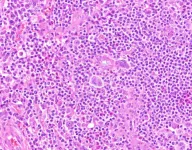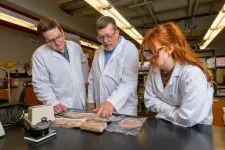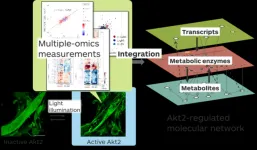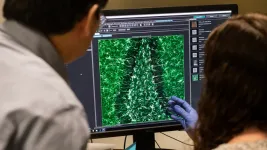(Press-News.org) BINGHAMTON, N.Y. – So much of modern life is spent on screens: Zoom meetings and websites, smartphones and videogames, televisions and social media. How are all those pixels and rectangles affecting how we see?
Binghamton University, State University of New York Professor of Psychology Peter Gerhardstein and doctoral candidate Nicholas Duggan explore the phenomenon in “Levels of Orientation Bias Differ Across Digital Content Categories: Implications for Visual Perception,” recently published in the journal Perception. Their paper covers the extent to which online content of various types differs from real images of natural, urban and suburban scenes in terms of visual orientation.
“When you’re online, you are experiencing a different world,” Gerhardstein said.
Gerhardstein and Duggan study the “oblique effect,” in which the brain pays more attention to horizontal and vertical lines than those coming in at an oblique angle. Think of it this way: In the natural world, you will see both horizontal phenomena such as the horizon, and vertical ones, most often trees. But you will also see objects oriented at a wide array of angles, such as tree branches, sloping hillsides and nodding flowers.
In a “carpentered” environment manufactured by human hands, many of those oblique angles are eliminated. Instead, the landscape is dominated by horizontal and vertical objects such as buildings, streetlamps, powerlines and road signs. Suburban environments, with their infusion of small pockets of nature, are somewhere in between.
Digital media, from Zoom video-calls and websites to video games, also exhibit the oblique effect. In the article, the researchers used Fourier analysis to investigate the visual orientation of a wide range of digital scenes, from cartoons and videogames to websites, and compared the results with real-life scenes from natural, suburban and urban environments.
They found that videogames meant to imitate the natural world actually do a passing job of it, preserving oblique angles, although not to the extent seen in nature. On the other end of the spectrum are pixilated videogames and social media sites, which are essentially primarily composed of boxes; these exhibit the oblique effect to an extreme not seen in real-world environments, their research shows.
“The question is: Is this shifting our overall profile of orientation sensitivity? People are spending so much time looking at these digital environments that it may become influential,” Duggan said.
Shifting perception
Over-exposure to digital content can potentially shift what your brain pays attention to visually — at least for a while. In a previous research project conducted with then-graduate student Daniel Hipp, students played Minecraft for four hours; afterward, their sensitivity to vertical and horizontal lines increased.
As seen with the Minecraft players, the oblique effect tends to fade once viewers reengage with the natural world and stop playing the game. On the other hand, research from Canada in the 1970s indicates that Indigenous people who were raised in naturalistic environments were more sensitive to oblique angles in general than those who grew up in an urban environment such as Toronto, Gerhardstein said.
“At this point, we really don’t know the implications of this,” he said.
The canary in the coal mine may be young people with digital media overuse disorder. Hipp, MS ’12, PhD ’15, is now a clinical neuroscience researcher in Colorado, where he is studying a group of high school and college students experiencing just that.
“We’re talking about kids who were dropping out of school because they play video games every waking moment. The conjecture is that these people may be subjecting themselves to a digital environment that is substantively different from what other people typically experience on a daily basis,” Gerhardstein explained.
Binghamton researchers are also working with Hipp’s group and have surveyed around 1,200 undergraduates about digital media overuse. While an article on the topic has yet to be published, they discovered that 90% of the sample reported frequent videogame use, and up to 10% worry about the amount of time they’re spending in game play.
Has their visual perception already been altered by their digital use? It’s a topic that merits further study.
Perceptual changes aren’t reflective of eyesight or necessarily negative, the researchers point out. Even after heavy digital use, people are able to perceive oblique angles; they just didn’t pay as much attention to them as horizontal and vertical lines.
“There is a lot of benefit to online content in general. Unless you are overusing it, we strongly suspect there is no real impact here,” Gerhardstein said. “But if you are heavily overusing digital content, you could be altering some aspects of your basic visual perception.”
END
Digital content could be altering your visual perception, new research shows
2023-02-21
ELSE PRESS RELEASES FROM THIS DATE:
NIH awards researchers $3.14 million grant to design novel model aimed at reducing healthcare disparities
2023-02-21
CLEVELAND: Supported by a new $3.14 million grant from the National Institutes of Health to Cleveland Clinic, researchers are using an emerging technology known as “digital twins” to better understand healthcare disparities based on where someone lives. Researchers from Cleveland Clinic and MetroHealth aim to use this information to develop strategies designed to reduce these disparities in health outcomes.
The research team, led by Jarrod Dalton, Ph.D., of Cleveland Clinic, and Adam Perzynski, Ph.D., of MetroHealth, ...
Study: Whole genome sequencing provides unprecedented detail on the genetic evolution of Hodgkin lymphoma
2023-02-21
(MIAMI, FL, FEB. 21, 2023) – To create the most effective, personalized treatment plans for patients with Hodgkin lymphoma or other cancers, scientists and clinicians need the clearest picture of the genetic changes leading to the cancer’s development. That picture, say scientists at Sylvester Comprehensive Cancer Center in the University of Miami Miller School of Medicine, comes into much better focus when whole genome sequencing – rather than the current standard, exome sequencing – is used to identify changes driving the cancer.
Exome sequencing, which reads only protein-coding genes, can detect some specific mutations and other variants that propel cancers, ...
Texas A&M meat scientist developing ‘no nitrite-added’ cured meats
2023-02-21
Written by Kay Ledbetter, 806-547-0002, skledbetter@ag.tamu.edu
Imagine your favorite cured meat like beef jerky, pepperoni or bacon without any added sodium nitrite from any source currently necessary for color and shelf life. Wes Osburn, Ph.D., is doing exactly that.
At center, Wes Osburn, Ph.D., Texas A&M University meat scientist, is working in his lab with students Tanner Wright and Arlie Reeves on a new no nitrite-added cured meat system. (Texas A&M AgriLife photo ...
Conifer-killing beetles use smell of beneficial fungus to select host trees
2023-02-21
Eurasian spruce bark beetles (Ips typographus) burrow into the bark of Norway spruce (Picea abies) trees where they mate and lay their eggs. Major outbreaks in Europe have decimated millions of hectares of conifer forests. The beetles preferentially attack trees that are already infected with symbiotic fungi (such as Grosmannia penicillata), which is thought to weaken host trees and break down their chemical defenses, allowing the beetles to successfully develop in the bark.
To investigate the chemical signals ...
Symbiotic fungi transform terpenes from spruce resin into attractants for bark beetles
2023-02-21
The mass outbreaks of bark beetles observed in recent years have caused shocking amounts of forest damage throughout Germany. As reported by the Federal Statistical Office in July 2022, more than 80% of the trees that had to be felled in the previous year were damaged by insects. The damaged timber felled due to insect damage amounted to more than 40 million cubic meters. One of the main pests is the European spruce beetle Ips typographus. In the Thuringian Forest and the Harz Mountains, for example, the beetle, which is only a few millimeters long, encountered spruce monocultures that had already been weakened by high temperatures and extended ...
Shining light on an enzyme reveals its role in metabolism
2023-02-21
Takeaki Ozawa and his team from the University of Tokyo reveal the metabolic reactions upon activating an enzyme called Akt2. In doing so, they reveal the inner workings of insulin-regulated metabolism. The findings lead the way for Akt2-targeting therapeutics for diabetes and metabolic disorders.
It takes energy to do anything—even to exist. You can metabolize food to convert glucose into energy: thanks to many cascades of molecular reactions within your cells. As soon as you eat, your pancreas secretes insulin hormone, which starts ...
Impact of key Alzheimer’s protein depends on type of brain cell in which it is produced
2023-02-21
SAN FRANCISCO, CA—February 21, 2023—Of all the known genetic risk factors for late-onset Alzheimer’s disease, the strongest is a gene for the protein called ApoE4. People with one copy of this gene are 3.5 times more likely, on average, to develop Alzheimer’s than others, and those with two copies face a 12-fold increased risk. However, exactly how ApoE4 boosts the risk of Alzheimer’s remains unclear.
Multiple types of cells in the brain make ApoE4—some of it is produced by neurons, but other brain cells called glia make it in higher quantities. For that reason, most prior research on this protein has focused on ...
Douglas Rhoads named AAAS Fellow
2023-02-21
University Professor Douglas Rhoads has been named a Fellow of the American Association for the Advancement of Science, the world’s largest general scientific society and publisher of the journal Science.
As one of only 20 fellows representing the Section on Agriculture, Food & Renewable Resources, Rhoads was chosen by his peers and colleagues for advancing science and its applications in service to society. The organization elected a total of 505 fellows across 24 scientific sections.
Rhoads is director of the Interdisciplinary ...
Pill for skin disease also curbs excessive drinking
2023-02-21
Researchers from Oregon Health & Science University and institutions across the country have identified a pill used to treat a common skin disease as an “incredibly promising” treatment for alcohol use disorder.
The study was recently published in the Journal of Clinical Investigation.
On average, the people who received the medication, called apremilast, reduced their alcohol intake by more than half — from five drinks per day to two.
“I’ve never seen anything like that before,” said co-senior author Angela Ozburn, Ph.D., associate professor of behavioral neuroscience in the OHSU School of Medicine and a research biologist ...
University of Ottawa physician is first Canadian winner of new award focused on health workforce wellness
2023-02-21
The University of Ottawa's Dr. Mamta Gautam is the first awardee of the AFMC Wellness Award, a new national honour that recognizes an individual in Canada who has shown dedication to the promotion and advancement of the wellness of physicians, medical students, and others.
“I am truly humbled and honoured. Promoting physician wellbeing is an area that I have been passionate about for over 30 years. To have the AFMC create an award to recognize contributions in this area lends further credibility to the importance of this topic,” ...







